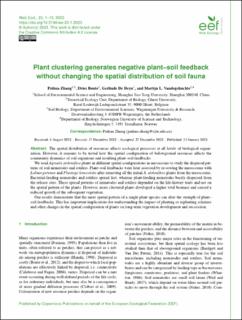| dc.contributor.author | Zhang, Peihua | |
| dc.contributor.author | Bonte, Dries | |
| dc.contributor.author | De Deyn, Gerlinde | |
| dc.contributor.author | Vandegehuchte, Martijn Lodewijk | |
| dc.date.accessioned | 2023-09-29T09:07:39Z | |
| dc.date.available | 2023-09-29T09:07:39Z | |
| dc.date.created | 2023-01-18T17:14:16Z | |
| dc.date.issued | 2023 | |
| dc.identifier.citation | Web Ecology. 2023, 23 (1), 1-15. | en_US |
| dc.identifier.issn | 1399-1183 | |
| dc.identifier.uri | https://hdl.handle.net/11250/3093008 | |
| dc.description.abstract | The spatial distribution of resources affects ecological processes at all levels of biological organization. However, it remains to be tested how the spatial configuration of belowground resources affects the community dynamics of soil organisms and resulting plant–soil feedbacks.
We used Agrostis stolonifera plants in different spatial configurations in mesocosms to study the dispersal patterns of soil nematodes and rotifers. Plant–soil feedbacks were later assessed by re-sowing the mesocosms with Lolium perenne and Plantago lanceolata after removing all the initial A. stolonifera plants from the mesocosms. Bacterial-feeding nematodes and rotifers spread fast, whereas plant-feeding nematodes barely dispersed from the release sites. These spread patterns of nematodes and rotifers depended on the life-history traits and not on the spatial pattern of the plants. However, more clustered plants developed a higher total biomass and caused a reduced growth of the subsequent vegetation.
Our results demonstrate that the mere spatial pattern of a single plant species can alter the strength of plant–soil feedbacks. This has important implications for understanding the impact of planting or replanting schemes and other changes in the spatial configuration of plants on long-term vegetation development and succession. | en_US |
| dc.language.iso | eng | en_US |
| dc.publisher | Copernicus Publications | en_US |
| dc.rights | Navngivelse 4.0 Internasjonal | * |
| dc.rights.uri | http://creativecommons.org/licenses/by/4.0/deed.no | * |
| dc.title | Plant clustering generates negative plant–soil feedback without changing the spatial distribution of soil fauna | en_US |
| dc.title.alternative | Plant clustering generates negative plant–soil feedback without changing the spatial distribution of soil fauna | en_US |
| dc.type | Peer reviewed | en_US |
| dc.type | Journal article | en_US |
| dc.description.version | publishedVersion | en_US |
| dc.source.pagenumber | 1-15 | en_US |
| dc.source.volume | 23 | en_US |
| dc.source.journal | Web Ecology | en_US |
| dc.source.issue | 1 | en_US |
| dc.identifier.doi | 10.5194/we-23-1-2023 | |
| dc.identifier.cristin | 2109806 | |
| cristin.ispublished | true | |
| cristin.fulltext | original | |
| cristin.qualitycode | 1 | |

